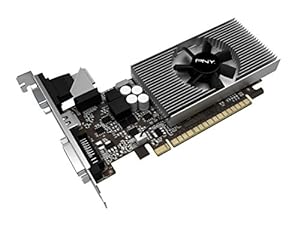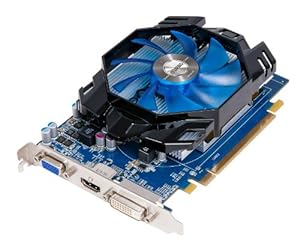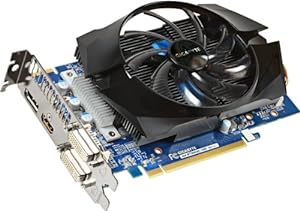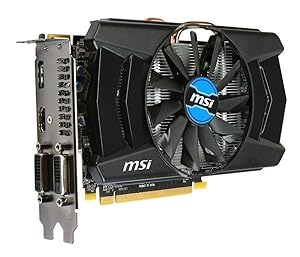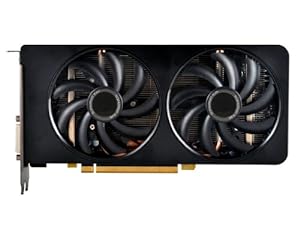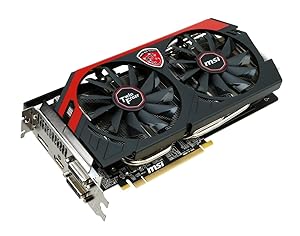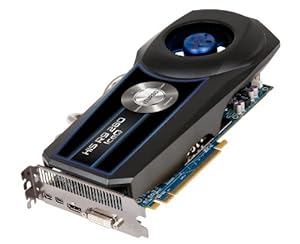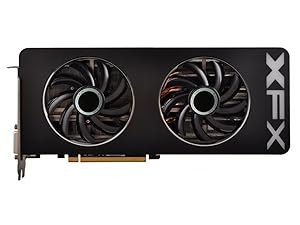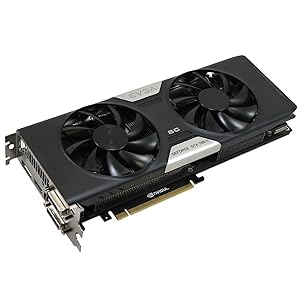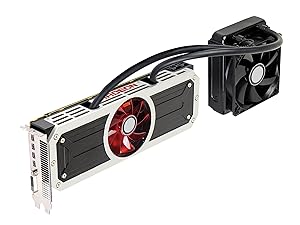- Aug 30, 2012
- 6,598
July 2014 Update: What’s new?
From AMD:
Dual-GPU, water-cooled, $1500 Radeon R9 295×2
AMD has launched the R9 295×2, its new flagship dual-GPU video card.
Thanks to the use of a water-cooling system (All-in-one, fairly easy to install in your case), the R9 295×2 runs at frequencies even higher than the R9 290X and it doesn’t compromise on performance, offering higher performance than Nvidia’s dual-GPU video card, the $3000 Titan Z.
Not only that, but its also more quiet. The R9 295×2 is an interesting option if you want a relatively cool and not too noisy dual-GPU setup in your PC. Otherwise, save yourself $700 and get two R9 290 that will offer nearly as much performance for slightly more than half the price but with more noise.
From Nvidia:
Dual-GPU, air-cooled, $3000 Geforce Titan Z:
Did I mention the $3000 price tag!?
Nvidia launched their own dual-GPU video card to compete with AMD’s R9 295×2, but unfortunately, it’s a disappointment. Its performance is lower and its price tag is twice as high. What more do I need to say?
Nvidia’s Geforce GT 740 and 730:
The GT 740 is a rebadge of the GTX 650 and is fairly uninteresting at its current price. However, the 64-bit GDDR5 equipped GT 730 is a great choice for $65.
Keep in mind:
1- These video card recommendations are for gamers who desire the best bang for their buck, or in other words, the best performance/features for their money. These video cards are way overkill if you don’t play videos games.
2- This list is based on the best U.S. and the best International prices (when available) fornew video cards from NewEgg, Amazon and/or B&H that I’ve seen as of July 18th 2014.
3- Each video card performance will vary depending on the game. Some games run better on Nvidia cards and some run better on AMD cards.
4- The resolution that I mention below should only be used as a guideline to give you an idea of the capability of the video card on recent games.
Best video card for $70:
Geforce GT 730 64-bit GDDR5
- $64.99 – PNY GeForce GT 730 1GB 64-bit GDDR5
- $71.51 – EVGA GeForce GT 730 1GB GDDR5 64bit
Replacing the previously recommend Radeon R7 240 1GB GDDR5
The Geforce GT 730, equipped GDDR5 memory on a 64-bit wide memory bus, definitely is a significant step-up in performance at the $70 price point.
If you’re on a very tight budget or if you only play older, not so demanding games or finally, if you play on a low resolution (1366 x 768/720p) monitor/HDTV, the Geforce GT 730 GDDR5 is an entry level video card perfectly capable of matching your needs.
Avoid models that come with DDR3 and 128-bit wide memory bus. Their performance is nothing like models equipped with GDDR5 and a 64-bit wide memory bus. Don’t waste your money on 2GB of memory either, it won’t make any difference in performance.
Note the PNY model is currently less expensive than the EVGA one. Both are just as good, so pick whichever one is the least expensive when you’re buying it.
Good to know:
This video card will do the job at 1366 x 768 or 1440 x 900, although you might have to lower details in some games. It also doesn’t need any additional power connector, it gets all the power that it needs from the PCI-Express 16x slot.
Best video card for $100:
Radeon R7 250X / Radeon 7770
- $89.99 – HIS R7 250X
- $99.99 – MSI Radeon R7 250X
- $99.99 – MSI Radeon HD 7770
- $109.95 – ASUS Radeon R7 250X at B&H (International Shipping)
For $100, the R7 250X, which is a rebrand of the often recommended Radeon 7770, is a force to be reckoned at this price.
Mind you, if you can spare an extra $20 for the R7 260X, do so, because it is a quite more capable video card.
The HIS model is currently $10 less, but the MSI R7 250X is $10 less after the Mail-in Rebate. MSI video cards tend to have less issues than HIS cards, not that HIS video cards are problematic, just a little less reliable than MSI’s. The MSI Radeon 7770 is exactly the same as the MSI R7 250X performance wise and is recommended if it costs less than the R7 250X. The ASUS R7 250X is slightly more expensive, but is available from B&H, who ships internationally.
Good to know:
This video card will do the job at 1440 x 900 and 1680 x 1050, although you might have to lower details in some games.
Best video card for $120:
Radeon R7 260X
- $119.99 – Gigabyte R7 260X 1GB
- $124.99 – XFX R7 260X 2GB from B&H (International Shipping)
Replacing the R7 260 is the R7 260X.
The R7 260X is pretty much the same video card as the Radeon HD 7790, with the same number of stream processors, but with even higher frequencies!
I’m recommending the R7 260X over the Geforce GTX 650 Ti simply because it’s faster in nearly every game.
Note that for $5 more, you can get the 2GB version from XFX, which is available from B&H who ships internationally.
What games can this video card handle?
The R7 260 is capable of handling the vast majority of games at 1600 x 900, although you might have to lower details for the most demanding games.
Best Video Card for $150:
Radeon R7 265
- $149.99 – MSI Radeon R7 265 2GB
- $159.99 – Gigabyte Radeon R7 265 2GBfrom B&H (International Shipping)
Replacing the previously recommended Radeon HD 7850 is the R7 265.
The R7 265 offers a small performance boost over the previously recommended Radeon HD 7850, thanks to its faster memory.
VS the competition:
Nvidia recently launched the Geforce GTX 750 Ti. While it’s an highly efficient video card that requires no additional power connector, its performance cannot match the R7 265.
Performance wise, the R7 265 2GB offers on average 19% higher FPS versus the Geforce GTX 750 Ti, according to AnandTech.
The MSI model is currently less expensive, but the Gigabyte model features a dual-fan cooling system, as well as higher core frequencies of 1008/1036Mhz, compared to 900/955MHz for the MSI. The Gigabyte model is also available internationally through B&H.
What games can this video card handle?
The Radeon R7 265 is capable of handling all games at 1600 x 900 with details at high, as well as most games at 1920 x 1080, although you will have to lower details in more recent and more demanding games.
Want the most powerful video card that doesn’t require an additional power connector?
If you have an older PC with a power supply that’s not powerful enough to handle power-hungry video cards but want a more powerful video card, the EVGA GeForce GTX 750Ti 2GB, available for $138.99 at Amazon or $145.04 at B&H (International Shipping) is what you want. Pulling all the power that it needs from the PCI-Express 16x slot, it’s a decently powerful video card that sips power.
Best Video Card for $170:
Radeon R9 270
- $164.99 – XFX R9 270 2GB
- $172.99 – XFX R9 270 2GB Single fan from B&H (International Shipping)
The R9 270 is basically is slightly slower version of the R7 270X that’s available for $25.
VS the competition:
Nvidia doesn’t have any product competing at this price point, AMD are basically competing with themselves
The first XFX model comes with a nice dual-fan system and a lifetime warranty if you register it within 30 days of purchase. The second model is available internationally through B&H.
What games can this video card handle?
The Radeon R7 270 is capable of handling all games at 1600 x 900 with details at high, as well as most games at 1920 x 1080, although you will have to lower details in more recent and more demanding games.
Best Video Card for $190:
Radeon R9 270X
- $189.99 – MSI Radeon R9 270X
- $189.99 – MSI Radeon R9 270X from B&H (International Shipping)
The Radeon R9 270X is basically a Radeon HD 7870 on steroids, with higher frequencies.
- The Radeon HD 7870 has a Core clock of 1050MHz and a memory frequency of 4800MHz.
- This particular MSI R9 270X has a core clock of 1030MHz, a Boost clock of 1080MHz and a memory frequency of 5600MHz.
V.S. R7 270:
Compared to the R7 270, the Radeon R9 270X basically has higher frequencies.
- The R9 270 recommended above features 1280 stream processors running at 900MHz (925MHz Boost) and 5.6GHz Memory
- The MSI R9 270X offers 1280 stream processors running at 1030MHz (1080MHz Boost) and 5.6GHz Memory. Its core frequency can be boosted up to 1120MHz if you want to.
So for $25 more, the R9 270X offers a nice performance bump over the R9 270. If you’re looking for a video card to handle games at 1920 x 1080 with medium/high/max details, the R9 270X is a good place to start if you can’t afford more expensive video cards.
What games can this video card handle?
The Radeon R9 270X 2GB is capable of handling most games at 1920 x 1080, although you might have to lower details in more recent and more demanding games.
Best video card for $210:
Radeon R9 280:
- $209.99 – HIS R9 280
- $240.23 – Gigabyte Geforce GTX 760 Dual fan from B&H (International Shipping)
With the previously recommended Geforce GTX 760 starting at $240-$250 and with the R9 280 starting at $210-$240, it’s easy to recommend the R9 280. It’s only a few % slower than the Geforce GTX 760, but quite a bit less expensive right now.
The HIS model is currently $30 less. Note that it takes a bit more than two slots worth of space inside a case, so if you want to add a second one in the future for Crossfire or if you have a smaller case with other expansions cards, it may not be the ideal choice for you. Gigabyte video cards tend to have less issues than HIS cards, not that HIS video cards are problematic, just a little less reliable than Gigabyte’s.
Keep in mind that while the R9 280 is less expensive in the USA, if you want your card delivered internationally from B&H, the Geforce GTX 760 is a slightly less expensive than the R9 280 there.
What games can this video card handle?
This card is capable of handling pretty much any game at a resolution of 1920 x 1080 with maximum visual quality, although you might have to scale back details in the most demanding games.
Best video card for $270:
Radeon R9 280X
- $269.99 – XFX R9 280X Dual fan
- $284.99 – MSI R9 280X Dual fan at B&H (International Shipping)
With the previously recommended Geforce GTX 770 starting at $300 and with the R9 280X starting at $270, it’s easy to recommend the R9 280X. It’s only a few % slower than the Geforce GTX 770, but quite a bit less expensive right now.
The XFX model runs at a 850Mhz base frequency and a 1000Mhz Boost frequency. The MSI R9 280X runs at a 1000Mhz base frequency with a 1050MHz Boost, so it’s a notch faster, but also $15 more. Note that the MSI model is available from B&H, who ships internationally.
What games can this video card handle?
This card will run any game at 1920 x 1200 (or 1080 for 1080p) maxed out, with less or more AA/AF, depending on the game, as well as most games at 2560 x 1600 without any problem. Gaming on multiple monitors is also possible, although you might have to turn settings down, depending on the game.
Best Video Card For $400:
Radeon R9 290 4GB:
- $391.99 – XFX Radeon R9 290 4GB
- $394.18 – Gigabyte R9 290 Triple fan at B&H (International Shipping)
The Radeon R9 290 is THE card to beat at this price point.
1- This card performs 10% faster than a GTX 780, yet it’s less than $400 vs to $470+ for a GTX 780.
2- Architecturally, the R9 290 is based on exactly the same Hawaii GPU as the R9 290X ($500+), AMD has kept intact virtually all the features of the R9 290X in the non “X” card including the 512-bit memory bus and 4GB of GDDR5, it performs merely 6% slower, making it the best bang for the buck currently available for both NVIDIA and AMD high end cards, in terms of speed/price ratio.
The downside?
The R9 290 consumes a lot of power and thus the cooling system has a lot of heat to dissipate. Models with custom coolers, like the one recommended here, run more quietly and perform as intended. Models with stock coolers are to avoid, as they are terribly noisy and worse, the cards can throttle to avoid overheating, thus reducing performance.
Alternative card for Crossfire setups:
If you intend to buy a second R9 290 for Crossfire, avoid the XFX model recommend above, as it will most likely overheat and throttle its performance run two of them in Crossfire. Instead, get the $400 – SAPPHIRE TRI-X OC Radeon R9 290 4GB, which has no problem when you run two in Crossfire.
What games can this video card handle?
This card will run any game at 1920 x 1200 (or 1080 for 1080p) maxed out, as well as games at 2560 x 1600 without any problem. Gaming with a 4K resolution or on multiple monitors is also possible, although you might have to turn settings down, depending on the game.
Best Video Card for $520:
Radeon R9 290X 4GB
- $517.06 – XFX R9 290X 4GB Dual-fan
- $517.06 – XFX R9 290X 4GB Dual-fan from B&H (International Shipping)
How does the XFX R9 290X compare to the XFX R9 290 recommended above?
The XFX R9 290 has 2560 stream processors running at 980MHz.
The XFX R9 290X has 2816 stream processors running at 1000MHz.
Overall, the XFX R9 290X is about 12% faster on average than the XFX R9 290.
What games can this video card handle?
This card will run any game at 1920 x 1200 (or 1080 for 1080p) maxed out, as well as games at 2560 x 1600 without any problem. Gaming with a 4K resolution or on multiple monitors is also possible, although you might have to turn settings down, depending on the game.
Best Video Card for $660:
EVGA Geforce GTX 780 Ti:
- $659.99 – EVGA GeForce GTX 780 Ti Superclocked w/Dual-fan Cooler 3GB
- $699.99 – ASUS GeForce GTX 780 Ti 3GB (lower frequencies, dual fan cooler) from B&H (International Shipping)
Replacing the EVGA Geforce GTX 780 Ti is the EVGA Geforce GTX 780 Ti Dual-fan SuperClocked, which features higher frequencies and an improved dual-fan cooling system.
Simply put, this card features the fastest single-GPU on the market, even faster than the Radeon R9 290X and the Geforce Titan Black, thanks to its SuperClockeded higher frequencies than the stock GTX 780 Ti.
The stock Geforce GTX 780 Ti is faster than the R9 290X by an average of 11%, according to AnandTech. It’s also far more quiet, thanks to the high-quality reference Nvidia cooler.
See, the Geforce GTX 780 Ti core runs at 875/928MHz (Core/Boost). That’s the reference model, you can find far higher clocked models for sale, such as the EVGA SuperClocked GTX 780 Ti, which runs at 1006/1072MHz.
The Geforce GTX Titan Black? Its core runs at 889/980 (Core/Boost). While it’s faster than the reference model of the GTX 780 Ti, it’s slower than the factory-overclocked Geforce GTX 780 Ti that are available for $730, compared to $1000+ for the Geforce Titan Black, if you can find one in stock that is.
So is there any reason to buy a Geforce GTX Titan Black? Only its 6GB of VRAM. Mind you, that’s of very-limited interest to gamers (only interesting if you run a triple 2560 x 1440/1600 monitor setup (11.1/12.3 Megapixels) or two 3840 x 2160 monitor setup (16.6MP) and want to buy three of them for a Three-Way SLI setup for a mere $3000) , but it can be interesting for a workstation instead of paying much more for a workstation-class video card.
Needless to say, the EVGA Geforce GTX 780 Ti SuperClocked has no problem outpacing the R9 290X, while consuming less power and being less noisy.
The ASUS Geforce GTX 780 Ti runs at lower frequencies (954MHz/1020MHz) than the EVGA SuperClocked, but it’s still faster than the stock frequencies of the GTX 780 Ti and of course, it offers higher performance than the R9 290X.
Note that if you intend on getting more than one, you’re better off with models that have a closed cooler, such as the ones recommended for SLI setups further down.
What games can this video card handle?
1080p and 2560 x 1600 is handled by this card without any problem. 4K and multiple monitors can also be handled, although you should consider a Crossfire or SLI setup for that.
Best Video Card For $800:
$800 – Two SAPPHIRE TRI-X OC Radeon R9 290 4GB in Crossfire
Upside: A LOT of performance for $800
Offering performance close to two Geforce GTX 780 Ti in SLI, while costing a whooping $650 less, two Radeon R9 290 in Crossfire a force to be reckoned with.
The downside: Power consumption, heat, and Crossfire profiles
Two Radeon R9 290 in Crossfire will consume a lot of power, emit a lot of heat and consequently, you will need a case with sufficient airflow to get rid of all that heat.
Thanks to the Sapphire triple-fan cooling system, noise is kept under control, unlike with reference AMD coolers which were deafening.
You also will have to deal with Crossfire profiles, updates and games that sometimes need an update to perform properly.
Micro-shuttering is no longer an issue with the R9 290 and 290X, thanks to fixes done at the hardware level.
Avoid: Geforce GTX 780 Ti Black
Just way too expensive for what it is.
Avoid: Two Radeon R9 290X in Crossfire
Not enough of a performance boost to justify spending $240 more compared to a R9 290 Crossfire setup.
Best Video Card for $1500:
Radeon R9 295×2
- $1472.99 – XFX Radeon R9 295×2
- $1569.99 – ASUS Radeon R9 295×2 from B&H (International Shipping)
Thanks to superior dual-GPU performance scaling, the R9 295×2 outperforms two Geforce GTX 780 Ti in SLI, while being compatible with more setups seeing as it’s a dual-GPU setup on a single card.
What settings can this setup handle?
Two Geforce GTX 780 Ti in SLI will have no problem running the latest games maxed out at a resolution of 1920 x 1080 (Full HD), 2560 x 1440/1600. Games at a resolution of 3840 x 2160 (Ultra HD/4K) and a triple 1080p monitor setup (6.2MP) should be able to run maxed out, although the most demanding ones might require you to slightly lower settings.
For a triple 2560 x 1440/1600 monitor setup (11.1/12.3 Megapixels) or two 3840 x 2160 monitor setup (16.6MP), I highly recommend upgrading to a three Geforce GTX 780 Ti in a Three-Way SLI setup or even better, two R9 295×2 in Quad Crossfire.
Best Video Card for $2150:
Three EVGA Geforce GTX 780 Ti in Three-Way SLI
- $2160 – Three EVGA GeForce GTX 780 Ti 3GB SuperClocked in Three-Way SLI or
- $2100 – Three EVGA GeForce GTX 780 Ti 3GB Reference frequencies in Three-Way SLIfrom B&H (International Shipping)
Want more performance? Time to step up to three Geforce GTX 780 Ti in Three-Way SLI.
Remember to plug the Nvidia Three-Way SLI bridge on the three cards to be able to enable Three-Way SLI. It’s included with the motherboard.
Make sure to get the latest version of the drivers straight from Nvidia, avoid those on the included DVD as those are outdated. There are updates on a regular basis, especially when new games are launched. New drivers fix bugs, increase performance and support newer games.
What settings can this setup handle?
Three Geforce GTX 780 Ti in a Three-Way SLI will easily run the latest games maxed out at a resolution of 1920 x 1080 (Full HD) or 2560 x 1440/1600, same with games at a resolution of 3840 x 2160 (Ultra HD/4K) and a triple 1080p monitor setup (6.2MP).
You should also be able to max out or run at high settings with games on a triple 2560 x 1440/1600 monitor setup (11.1/12.3 Megapixels) and with slightly lower settings (lower AA/AF) for a two 3840 x 2160 monitor setup (16.6MP).
Note that for Three-Way SLI, I recommend the blower style cooling system, which exhausts the hot air outside of the case, which is preferable for a multiple video card setup.
Best Video Card for $3000:
Two Radeon R9 295×2 in Quad Crossfire
- $2946 – Two (2x) XFX Radeon R9 295×2
- $3140 – Two (2x) ASUS Radeon R9 295×2 from B&H (International Shipping)
Thanks to superior dual-GPU performance scaling, the R9 295×2 outperforms two Geforce GTX 780 Ti in SLI, while being compatible with more setups seeing as it’s a dual-GPU setup on a single card.
What settings can this setup handle?
Two Radeon R9 295×2 in Quad Crossfire will have no problem running the latest games maxed out at a resolution of 1920 x 1080 (Full HD), 2560 x 1440/1600, 3840 x 2160 (Ultra HD/4K) or on a triple 1080p monitor setup (6.2MP)
For a triple 2560 x 1440/1600 monitor setup (11.1/12.3 Megapixels) or two 3840 x 2160 monitor setup (16.6MP), this is the ideal setup
A few important recommendations and notes regarding video cards:
1- Get the latest version of the video card drivers directly from AMD or Nvidia. This will ensure that you get the latest bug fixes and the best performance possible from your video card(s).
2- To confirm whether Crossfire or SLI is working or not, use GPU-Z which will show that information to you in the last field at the bottom of the program.
3- SLI Guide: How to enable SLI, check if SLI is enabled, actually working in your game and what to do if it’s not is a great guide from the Notebook Review forums.
4- When using two or more video cards in Crossfire or SLI, you want to connect your monitors into the top video card, i.e. the video card that is the closest to the CPU.
5- Most video cards require one or two PCI-Express 6 or 8 pin power connector(s) to be plugged into them to function properly. Make sure that your power supply comes equipped with enough 6 and/or 8 pin connectors for your video cards.
HardwareRevolution
From AMD:
Dual-GPU, water-cooled, $1500 Radeon R9 295×2
AMD has launched the R9 295×2, its new flagship dual-GPU video card.
Thanks to the use of a water-cooling system (All-in-one, fairly easy to install in your case), the R9 295×2 runs at frequencies even higher than the R9 290X and it doesn’t compromise on performance, offering higher performance than Nvidia’s dual-GPU video card, the $3000 Titan Z.
Not only that, but its also more quiet. The R9 295×2 is an interesting option if you want a relatively cool and not too noisy dual-GPU setup in your PC. Otherwise, save yourself $700 and get two R9 290 that will offer nearly as much performance for slightly more than half the price but with more noise.
From Nvidia:
Dual-GPU, air-cooled, $3000 Geforce Titan Z:
Did I mention the $3000 price tag!?
Nvidia launched their own dual-GPU video card to compete with AMD’s R9 295×2, but unfortunately, it’s a disappointment. Its performance is lower and its price tag is twice as high. What more do I need to say?
Nvidia’s Geforce GT 740 and 730:
The GT 740 is a rebadge of the GTX 650 and is fairly uninteresting at its current price. However, the 64-bit GDDR5 equipped GT 730 is a great choice for $65.
Keep in mind:
1- These video card recommendations are for gamers who desire the best bang for their buck, or in other words, the best performance/features for their money. These video cards are way overkill if you don’t play videos games.
2- This list is based on the best U.S. and the best International prices (when available) fornew video cards from NewEgg, Amazon and/or B&H that I’ve seen as of July 18th 2014.
3- Each video card performance will vary depending on the game. Some games run better on Nvidia cards and some run better on AMD cards.
4- The resolution that I mention below should only be used as a guideline to give you an idea of the capability of the video card on recent games.
Best video card for $70:
Geforce GT 730 64-bit GDDR5
- $64.99 – PNY GeForce GT 730 1GB 64-bit GDDR5
- $71.51 – EVGA GeForce GT 730 1GB GDDR5 64bit
Replacing the previously recommend Radeon R7 240 1GB GDDR5
The Geforce GT 730, equipped GDDR5 memory on a 64-bit wide memory bus, definitely is a significant step-up in performance at the $70 price point.
If you’re on a very tight budget or if you only play older, not so demanding games or finally, if you play on a low resolution (1366 x 768/720p) monitor/HDTV, the Geforce GT 730 GDDR5 is an entry level video card perfectly capable of matching your needs.
Avoid models that come with DDR3 and 128-bit wide memory bus. Their performance is nothing like models equipped with GDDR5 and a 64-bit wide memory bus. Don’t waste your money on 2GB of memory either, it won’t make any difference in performance.
Note the PNY model is currently less expensive than the EVGA one. Both are just as good, so pick whichever one is the least expensive when you’re buying it.
Good to know:
This video card will do the job at 1366 x 768 or 1440 x 900, although you might have to lower details in some games. It also doesn’t need any additional power connector, it gets all the power that it needs from the PCI-Express 16x slot.
Best video card for $100:
Radeon R7 250X / Radeon 7770
- $89.99 – HIS R7 250X
- $99.99 – MSI Radeon R7 250X
- $99.99 – MSI Radeon HD 7770
- $109.95 – ASUS Radeon R7 250X at B&H (International Shipping)
For $100, the R7 250X, which is a rebrand of the often recommended Radeon 7770, is a force to be reckoned at this price.
Mind you, if you can spare an extra $20 for the R7 260X, do so, because it is a quite more capable video card.
The HIS model is currently $10 less, but the MSI R7 250X is $10 less after the Mail-in Rebate. MSI video cards tend to have less issues than HIS cards, not that HIS video cards are problematic, just a little less reliable than MSI’s. The MSI Radeon 7770 is exactly the same as the MSI R7 250X performance wise and is recommended if it costs less than the R7 250X. The ASUS R7 250X is slightly more expensive, but is available from B&H, who ships internationally.
Good to know:
This video card will do the job at 1440 x 900 and 1680 x 1050, although you might have to lower details in some games.
Best video card for $120:
Radeon R7 260X
- $119.99 – Gigabyte R7 260X 1GB
- $124.99 – XFX R7 260X 2GB from B&H (International Shipping)
Replacing the R7 260 is the R7 260X.
The R7 260X is pretty much the same video card as the Radeon HD 7790, with the same number of stream processors, but with even higher frequencies!
I’m recommending the R7 260X over the Geforce GTX 650 Ti simply because it’s faster in nearly every game.
Note that for $5 more, you can get the 2GB version from XFX, which is available from B&H who ships internationally.
What games can this video card handle?
The R7 260 is capable of handling the vast majority of games at 1600 x 900, although you might have to lower details for the most demanding games.
Best Video Card for $150:
Radeon R7 265
- $149.99 – MSI Radeon R7 265 2GB
- $159.99 – Gigabyte Radeon R7 265 2GBfrom B&H (International Shipping)
Replacing the previously recommended Radeon HD 7850 is the R7 265.
The R7 265 offers a small performance boost over the previously recommended Radeon HD 7850, thanks to its faster memory.
VS the competition:
Nvidia recently launched the Geforce GTX 750 Ti. While it’s an highly efficient video card that requires no additional power connector, its performance cannot match the R7 265.
Performance wise, the R7 265 2GB offers on average 19% higher FPS versus the Geforce GTX 750 Ti, according to AnandTech.
The MSI model is currently less expensive, but the Gigabyte model features a dual-fan cooling system, as well as higher core frequencies of 1008/1036Mhz, compared to 900/955MHz for the MSI. The Gigabyte model is also available internationally through B&H.
What games can this video card handle?
The Radeon R7 265 is capable of handling all games at 1600 x 900 with details at high, as well as most games at 1920 x 1080, although you will have to lower details in more recent and more demanding games.
Want the most powerful video card that doesn’t require an additional power connector?
If you have an older PC with a power supply that’s not powerful enough to handle power-hungry video cards but want a more powerful video card, the EVGA GeForce GTX 750Ti 2GB, available for $138.99 at Amazon or $145.04 at B&H (International Shipping) is what you want. Pulling all the power that it needs from the PCI-Express 16x slot, it’s a decently powerful video card that sips power.
Best Video Card for $170:
Radeon R9 270
- $164.99 – XFX R9 270 2GB
- $172.99 – XFX R9 270 2GB Single fan from B&H (International Shipping)
The R9 270 is basically is slightly slower version of the R7 270X that’s available for $25.
VS the competition:
Nvidia doesn’t have any product competing at this price point, AMD are basically competing with themselves
The first XFX model comes with a nice dual-fan system and a lifetime warranty if you register it within 30 days of purchase. The second model is available internationally through B&H.
What games can this video card handle?
The Radeon R7 270 is capable of handling all games at 1600 x 900 with details at high, as well as most games at 1920 x 1080, although you will have to lower details in more recent and more demanding games.
Best Video Card for $190:
Radeon R9 270X
- $189.99 – MSI Radeon R9 270X
- $189.99 – MSI Radeon R9 270X from B&H (International Shipping)
The Radeon R9 270X is basically a Radeon HD 7870 on steroids, with higher frequencies.
- The Radeon HD 7870 has a Core clock of 1050MHz and a memory frequency of 4800MHz.
- This particular MSI R9 270X has a core clock of 1030MHz, a Boost clock of 1080MHz and a memory frequency of 5600MHz.
V.S. R7 270:
Compared to the R7 270, the Radeon R9 270X basically has higher frequencies.
- The R9 270 recommended above features 1280 stream processors running at 900MHz (925MHz Boost) and 5.6GHz Memory
- The MSI R9 270X offers 1280 stream processors running at 1030MHz (1080MHz Boost) and 5.6GHz Memory. Its core frequency can be boosted up to 1120MHz if you want to.
So for $25 more, the R9 270X offers a nice performance bump over the R9 270. If you’re looking for a video card to handle games at 1920 x 1080 with medium/high/max details, the R9 270X is a good place to start if you can’t afford more expensive video cards.
What games can this video card handle?
The Radeon R9 270X 2GB is capable of handling most games at 1920 x 1080, although you might have to lower details in more recent and more demanding games.
Best video card for $210:
Radeon R9 280:
- $209.99 – HIS R9 280
- $240.23 – Gigabyte Geforce GTX 760 Dual fan from B&H (International Shipping)
With the previously recommended Geforce GTX 760 starting at $240-$250 and with the R9 280 starting at $210-$240, it’s easy to recommend the R9 280. It’s only a few % slower than the Geforce GTX 760, but quite a bit less expensive right now.
The HIS model is currently $30 less. Note that it takes a bit more than two slots worth of space inside a case, so if you want to add a second one in the future for Crossfire or if you have a smaller case with other expansions cards, it may not be the ideal choice for you. Gigabyte video cards tend to have less issues than HIS cards, not that HIS video cards are problematic, just a little less reliable than Gigabyte’s.
Keep in mind that while the R9 280 is less expensive in the USA, if you want your card delivered internationally from B&H, the Geforce GTX 760 is a slightly less expensive than the R9 280 there.
What games can this video card handle?
This card is capable of handling pretty much any game at a resolution of 1920 x 1080 with maximum visual quality, although you might have to scale back details in the most demanding games.
Best video card for $270:
Radeon R9 280X
- $269.99 – XFX R9 280X Dual fan
- $284.99 – MSI R9 280X Dual fan at B&H (International Shipping)
With the previously recommended Geforce GTX 770 starting at $300 and with the R9 280X starting at $270, it’s easy to recommend the R9 280X. It’s only a few % slower than the Geforce GTX 770, but quite a bit less expensive right now.
The XFX model runs at a 850Mhz base frequency and a 1000Mhz Boost frequency. The MSI R9 280X runs at a 1000Mhz base frequency with a 1050MHz Boost, so it’s a notch faster, but also $15 more. Note that the MSI model is available from B&H, who ships internationally.
What games can this video card handle?
This card will run any game at 1920 x 1200 (or 1080 for 1080p) maxed out, with less or more AA/AF, depending on the game, as well as most games at 2560 x 1600 without any problem. Gaming on multiple monitors is also possible, although you might have to turn settings down, depending on the game.
Best Video Card For $400:
Radeon R9 290 4GB:
- $391.99 – XFX Radeon R9 290 4GB
- $394.18 – Gigabyte R9 290 Triple fan at B&H (International Shipping)
The Radeon R9 290 is THE card to beat at this price point.
1- This card performs 10% faster than a GTX 780, yet it’s less than $400 vs to $470+ for a GTX 780.
2- Architecturally, the R9 290 is based on exactly the same Hawaii GPU as the R9 290X ($500+), AMD has kept intact virtually all the features of the R9 290X in the non “X” card including the 512-bit memory bus and 4GB of GDDR5, it performs merely 6% slower, making it the best bang for the buck currently available for both NVIDIA and AMD high end cards, in terms of speed/price ratio.
The downside?
The R9 290 consumes a lot of power and thus the cooling system has a lot of heat to dissipate. Models with custom coolers, like the one recommended here, run more quietly and perform as intended. Models with stock coolers are to avoid, as they are terribly noisy and worse, the cards can throttle to avoid overheating, thus reducing performance.
Alternative card for Crossfire setups:
If you intend to buy a second R9 290 for Crossfire, avoid the XFX model recommend above, as it will most likely overheat and throttle its performance run two of them in Crossfire. Instead, get the $400 – SAPPHIRE TRI-X OC Radeon R9 290 4GB, which has no problem when you run two in Crossfire.
What games can this video card handle?
This card will run any game at 1920 x 1200 (or 1080 for 1080p) maxed out, as well as games at 2560 x 1600 without any problem. Gaming with a 4K resolution or on multiple monitors is also possible, although you might have to turn settings down, depending on the game.
Best Video Card for $520:
Radeon R9 290X 4GB
- $517.06 – XFX R9 290X 4GB Dual-fan
- $517.06 – XFX R9 290X 4GB Dual-fan from B&H (International Shipping)
How does the XFX R9 290X compare to the XFX R9 290 recommended above?
The XFX R9 290 has 2560 stream processors running at 980MHz.
The XFX R9 290X has 2816 stream processors running at 1000MHz.
Overall, the XFX R9 290X is about 12% faster on average than the XFX R9 290.
What games can this video card handle?
This card will run any game at 1920 x 1200 (or 1080 for 1080p) maxed out, as well as games at 2560 x 1600 without any problem. Gaming with a 4K resolution or on multiple monitors is also possible, although you might have to turn settings down, depending on the game.
Best Video Card for $660:
EVGA Geforce GTX 780 Ti:
- $659.99 – EVGA GeForce GTX 780 Ti Superclocked w/Dual-fan Cooler 3GB
- $699.99 – ASUS GeForce GTX 780 Ti 3GB (lower frequencies, dual fan cooler) from B&H (International Shipping)
Replacing the EVGA Geforce GTX 780 Ti is the EVGA Geforce GTX 780 Ti Dual-fan SuperClocked, which features higher frequencies and an improved dual-fan cooling system.
Simply put, this card features the fastest single-GPU on the market, even faster than the Radeon R9 290X and the Geforce Titan Black, thanks to its SuperClockeded higher frequencies than the stock GTX 780 Ti.
The stock Geforce GTX 780 Ti is faster than the R9 290X by an average of 11%, according to AnandTech. It’s also far more quiet, thanks to the high-quality reference Nvidia cooler.
See, the Geforce GTX 780 Ti core runs at 875/928MHz (Core/Boost). That’s the reference model, you can find far higher clocked models for sale, such as the EVGA SuperClocked GTX 780 Ti, which runs at 1006/1072MHz.
The Geforce GTX Titan Black? Its core runs at 889/980 (Core/Boost). While it’s faster than the reference model of the GTX 780 Ti, it’s slower than the factory-overclocked Geforce GTX 780 Ti that are available for $730, compared to $1000+ for the Geforce Titan Black, if you can find one in stock that is.
So is there any reason to buy a Geforce GTX Titan Black? Only its 6GB of VRAM. Mind you, that’s of very-limited interest to gamers (only interesting if you run a triple 2560 x 1440/1600 monitor setup (11.1/12.3 Megapixels) or two 3840 x 2160 monitor setup (16.6MP) and want to buy three of them for a Three-Way SLI setup for a mere $3000) , but it can be interesting for a workstation instead of paying much more for a workstation-class video card.
Needless to say, the EVGA Geforce GTX 780 Ti SuperClocked has no problem outpacing the R9 290X, while consuming less power and being less noisy.
The ASUS Geforce GTX 780 Ti runs at lower frequencies (954MHz/1020MHz) than the EVGA SuperClocked, but it’s still faster than the stock frequencies of the GTX 780 Ti and of course, it offers higher performance than the R9 290X.
Note that if you intend on getting more than one, you’re better off with models that have a closed cooler, such as the ones recommended for SLI setups further down.
What games can this video card handle?
1080p and 2560 x 1600 is handled by this card without any problem. 4K and multiple monitors can also be handled, although you should consider a Crossfire or SLI setup for that.
Best Video Card For $800:
$800 – Two SAPPHIRE TRI-X OC Radeon R9 290 4GB in Crossfire
Upside: A LOT of performance for $800
Offering performance close to two Geforce GTX 780 Ti in SLI, while costing a whooping $650 less, two Radeon R9 290 in Crossfire a force to be reckoned with.
The downside: Power consumption, heat, and Crossfire profiles
Two Radeon R9 290 in Crossfire will consume a lot of power, emit a lot of heat and consequently, you will need a case with sufficient airflow to get rid of all that heat.
Thanks to the Sapphire triple-fan cooling system, noise is kept under control, unlike with reference AMD coolers which were deafening.
You also will have to deal with Crossfire profiles, updates and games that sometimes need an update to perform properly.
Micro-shuttering is no longer an issue with the R9 290 and 290X, thanks to fixes done at the hardware level.
Avoid: Geforce GTX 780 Ti Black
Just way too expensive for what it is.
Avoid: Two Radeon R9 290X in Crossfire
Not enough of a performance boost to justify spending $240 more compared to a R9 290 Crossfire setup.
Best Video Card for $1500:
Radeon R9 295×2
- $1472.99 – XFX Radeon R9 295×2
- $1569.99 – ASUS Radeon R9 295×2 from B&H (International Shipping)
Thanks to superior dual-GPU performance scaling, the R9 295×2 outperforms two Geforce GTX 780 Ti in SLI, while being compatible with more setups seeing as it’s a dual-GPU setup on a single card.
What settings can this setup handle?
Two Geforce GTX 780 Ti in SLI will have no problem running the latest games maxed out at a resolution of 1920 x 1080 (Full HD), 2560 x 1440/1600. Games at a resolution of 3840 x 2160 (Ultra HD/4K) and a triple 1080p monitor setup (6.2MP) should be able to run maxed out, although the most demanding ones might require you to slightly lower settings.
For a triple 2560 x 1440/1600 monitor setup (11.1/12.3 Megapixels) or two 3840 x 2160 monitor setup (16.6MP), I highly recommend upgrading to a three Geforce GTX 780 Ti in a Three-Way SLI setup or even better, two R9 295×2 in Quad Crossfire.
Best Video Card for $2150:
Three EVGA Geforce GTX 780 Ti in Three-Way SLI
- $2160 – Three EVGA GeForce GTX 780 Ti 3GB SuperClocked in Three-Way SLI or
- $2100 – Three EVGA GeForce GTX 780 Ti 3GB Reference frequencies in Three-Way SLIfrom B&H (International Shipping)
Want more performance? Time to step up to three Geforce GTX 780 Ti in Three-Way SLI.
Remember to plug the Nvidia Three-Way SLI bridge on the three cards to be able to enable Three-Way SLI. It’s included with the motherboard.
Make sure to get the latest version of the drivers straight from Nvidia, avoid those on the included DVD as those are outdated. There are updates on a regular basis, especially when new games are launched. New drivers fix bugs, increase performance and support newer games.
What settings can this setup handle?
Three Geforce GTX 780 Ti in a Three-Way SLI will easily run the latest games maxed out at a resolution of 1920 x 1080 (Full HD) or 2560 x 1440/1600, same with games at a resolution of 3840 x 2160 (Ultra HD/4K) and a triple 1080p monitor setup (6.2MP).
You should also be able to max out or run at high settings with games on a triple 2560 x 1440/1600 monitor setup (11.1/12.3 Megapixels) and with slightly lower settings (lower AA/AF) for a two 3840 x 2160 monitor setup (16.6MP).
Note that for Three-Way SLI, I recommend the blower style cooling system, which exhausts the hot air outside of the case, which is preferable for a multiple video card setup.
Best Video Card for $3000:
Two Radeon R9 295×2 in Quad Crossfire
- $2946 – Two (2x) XFX Radeon R9 295×2
- $3140 – Two (2x) ASUS Radeon R9 295×2 from B&H (International Shipping)
Thanks to superior dual-GPU performance scaling, the R9 295×2 outperforms two Geforce GTX 780 Ti in SLI, while being compatible with more setups seeing as it’s a dual-GPU setup on a single card.
What settings can this setup handle?
Two Radeon R9 295×2 in Quad Crossfire will have no problem running the latest games maxed out at a resolution of 1920 x 1080 (Full HD), 2560 x 1440/1600, 3840 x 2160 (Ultra HD/4K) or on a triple 1080p monitor setup (6.2MP)
For a triple 2560 x 1440/1600 monitor setup (11.1/12.3 Megapixels) or two 3840 x 2160 monitor setup (16.6MP), this is the ideal setup
A few important recommendations and notes regarding video cards:
1- Get the latest version of the video card drivers directly from AMD or Nvidia. This will ensure that you get the latest bug fixes and the best performance possible from your video card(s).
2- To confirm whether Crossfire or SLI is working or not, use GPU-Z which will show that information to you in the last field at the bottom of the program.
3- SLI Guide: How to enable SLI, check if SLI is enabled, actually working in your game and what to do if it’s not is a great guide from the Notebook Review forums.
4- When using two or more video cards in Crossfire or SLI, you want to connect your monitors into the top video card, i.e. the video card that is the closest to the CPU.
5- Most video cards require one or two PCI-Express 6 or 8 pin power connector(s) to be plugged into them to function properly. Make sure that your power supply comes equipped with enough 6 and/or 8 pin connectors for your video cards.
HardwareRevolution
